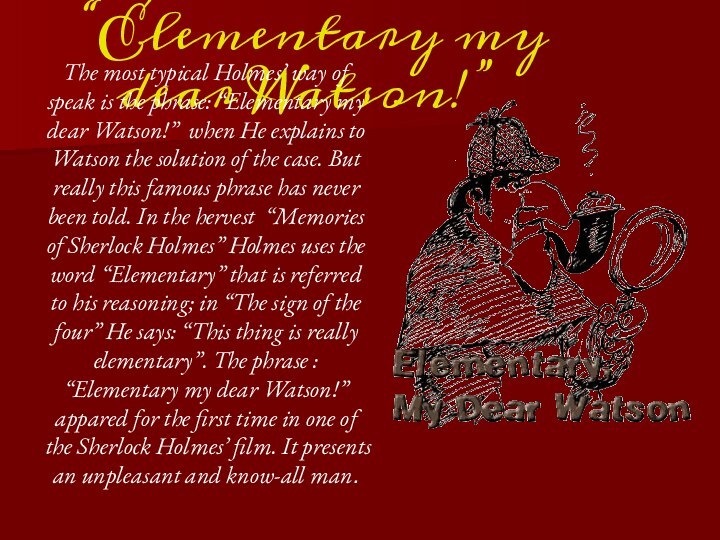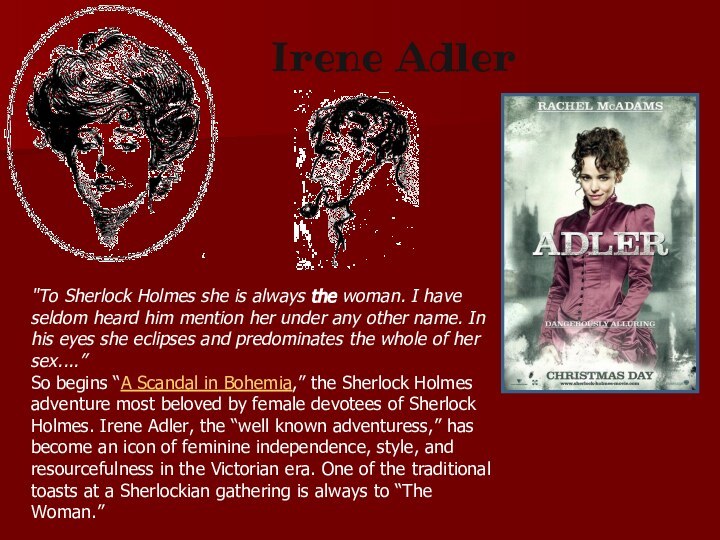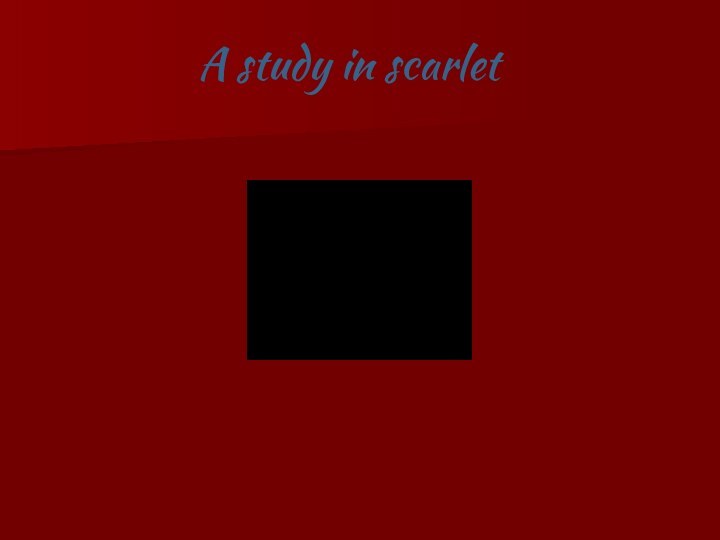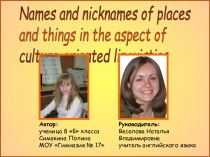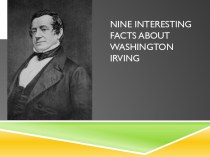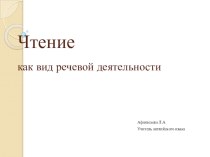Слайд 2
Sherlock Holmes
First appearance: 1887
Created by: Sir Arthur Conan
Doyle
Episode count: Four Novels
Fifty-six
short stories
Canon of Sherlock Holmes
Information
Gender: Male
Occupation: Consulting detective
Family: Mycrosoft Holmes (brother)
Nationality: English
Слайд 3
Arthur Conan Doyle
(22 May 1859 – 7
July 1930)
Sir Arthur Ignatius Conan Doyle was born
in Edinburgh in 1859 of Irish Catholic parents. He was a British physician and writer, most noted for his stories about the detective Sherlock Holmes. He was a prolific writer whose other works include science fiction stories, historical novels, plays and romances, poetry, and non-fiction. He graduated in medicine in 1881 and then practiced as a doctor in Britain and abroad: in a Green-land whaler, a West African trader, a Boer War Hospital. Conan Doyle died in 1930.
Слайд 4
Sherlock Holmes is a fictional character of the
late nineteenth and early twentieth centuries who first appeared
in publication in 1887. He is the creation of Scottish author and physician Sir Arthur Conan Doyle. A brilliant London-based "consulting detective", Holmes is famous for his intellectual prowess and is renowned for his skilful use of astute observation, deductive reasoning (though in reality, he uses abductive reasoning) and forensic skills to solve difficult cases.
Conan Doyle wrote four novels and fifty-six short stories that feature Holmes. The first story, A Study in Scarlet, appeared in Beeton's Christmas Annual in 1887 and Lippincott’s Monthly Magazine in 1890, respectively.
All but four stories are narrated by Holmes‘ friend and biographer, Dr. John H. Watson, two are narrated by Holmes himself and two others are written in the third person.
SHERLOCK HOLMES: INTRODUCTION
Слайд 5
Biography: Early life
Explicit details about Sherlock Holmes'
life outside of the adventures recorded by Dr. Watson
are few and far between in Conan Doyle's original stories; nevertheless, incidental details about his early life and extended families do construct a loose biographical picture of the detective.From 1881, Holmes is described as having lodgings at 221 B Baker Street, London, from where he runs his private detective agency. 221B is a flat up seventeen steps, stated in an early manuscript to be at the "upper end" of the road. Until the arrival of Dr. Watson, Holmes works alone, only occasionally employing agents from the city's underclass, including a host of informants and a group of street children he calls the Baker Street Irregulars. Little is said of Holmes' family. His parents are unmentioned in the stories and he merely states that his ancestors were "country squires".
Слайд 6
Habits and personality
Watson describes Holmes as “bohemian"
in habits and lifestyle. According to Watson, Holmes is
an eccentric, with no regard for contemporary standards of tidiness or good order. What appears to others as chaos, however, is to Holmes a wealth of useful information. Throughout the stories, Holmes would dive into his apparent mess of random papers and artifacts, only to retrieve precisely the specific document or eclectic item he was looking for. In matters of personal hygiene, by contrast, Holmes is described in “The Hound of the Baskervilles" as having a "cat-like" love of personal cleanliness. His chronicler does not consider Holmes' habitual use of a pipe, or his less-frequent use of cigarettes and cigars, a vice.
Слайд 7
Life with Dr Watson
Holmes shares the majority
of his professional years with his good friend and
chronicler Watson, who lives with Holmes for some time before his marriage in 1887, and again after his wife’s death; his residence is maintained by his landlady, Mrs Hudson. Watson has two roles in Holmes' life. First, he gives practical assistance in the conduct of his cases; he is the detective's right-hand man, acting variously as look-out, decoy, accomplice and messenger. Second, he is Holmes' chronicler (his “Boswell" as Holmes refers to him). Most of the Holmes stories are frame narratives, written from Watson's point of view as summaries of the detective's most interesting cases.
Слайд 8
Retirement
Holmes retires to a bee farm on
the Sussex Downs in 1903-04, where he takes up
the hobby of beekeeping as his primary occupation, eventually producing a "Practical Handbook of Bee Culture, with some Observations upon the Segregation of the Queen." Only one adventure, narrated by Holmes himself pursuing the case as an amateur, takes place during the detective's retirement.
Слайд 9
Knowledge and skills
Dr Watson subsequently assesses Holmes'
abilities thus:
1. Knowledge of Literature — Nothing.
2. Knowledge
of Philosophy — Nothing.
3. Knowledge of Astronomy — Nothing.
4. Knowledge of Politics — Feeble.
5. Knowledge of Botany — Variable. Well up in belladonna, opium and poisons generally. Knows nothing of practical gardening.
6. Knowledge of Geology — Practical, but limited. Tells at a glance different soils from each other. After walks, has shown me splashes upon his trousers, and told me by their colour and consistence in what part of London he had received them.
7. Knowledge of Chemistry — Profound.
8. Knowledge of Anatomy — Accurate, but unsystematic.
9. Knowledge of Sensational Literature — Immense. He appears to know every detail of every horror perpetrated in the century.
10. Plays the violin well.
11. Is an expert singlestick player, boxer and swordsman.
12. Has a good practical knowledge of British law.
Слайд 10
Holmes is also an occasional user of morphine,
but expressed strong disapproval on visiting an opium den.
All three were legal in late-19th-century England. Both Watson and Holmes are serial tobacco users, including cigarettes, cigars and pipes. Indeed, Holmes is expert at identifying tobacco ash residues, having penned a monograph on the subject.
Dr Watson reflects Victorian medical orthodoxy by having no medical objection to Holmes' drug use. Morally, he disapproves of his friend's habit, describing it as the detective's "only vice," and expressing concern over its possible effect on Holmes' mental health and superior intellect. In later stories, Watson claims to have "weaned" Holmes off drugs. Even so, according to his doctor friend, Holmes remains an addict whose habit is "not dead, but merely sleeping."
Use of drugs
Слайд 11
Role in the history of the detective story
Although Sherlock Holmes isn't the original fiction detective (he
was influenced by Edgar Allan Poe's C. Auguste Dupin and Émile Gaboriau's Monsieur Lecoq), his name has become a by-word for the part. His stories also include several detective story characters such as the loyal but less intelligent assistant, a role for which Dr Watson has become the archetype. The investigating detective became a popular genre with many authors such as Agatha Christie and Dorothy Sayers after the demise of Holmes, with characters such as Hercule Poirot, and Lord Peter Wimsey. Forensic methods become less important than the psychology of the criminal, despite the strong growth in forensics in use by the police in the early 20th century.
Слайд 12
Methods of detection:
Holmesian deduction
Holmes' primary intellectual detection
method is deductive reasoning of the solution to a
crime. "From a drop of water," he writes, "a logician could infer the possibility of an Atlantic or a Niagara without having seen or heard of one or the other."Holmes stories often begin with a bravura display of his talent for "deduction". It is of some interest to logicians and those interested in logic to try to analyse just what Holmes is doing when he performs his deduction. Holmesian deduction appears to consist primarily of drawing inferences based on either straightforward practical principles—which are the result of careful inductive study, such as Holmes's study of different kinds of cigar ashes—or inference to the best explanation.
Слайд 13
“Elementary my dear Watson!”
The most typical Holmes’ way
of speak is the phrase: “Elementary my dear Watson!”
when He explains to Watson the solution of the case. But really this famous phrase has never been told. In the hervest “Memories of Sherlock Holmes” Holmes uses the word “Elementary” that is referred to his reasoning; in “The sign of the four” He says: “This thing is really elementary”. The phrase : “Elementary my dear Watson!” appared for the first time in one of the Sherlock Holmes’ film. It presents an unpleasant and know-all man.
Слайд 14
A Study in Scarlet
A Study in Scarlet
is a detective mystery novel written by British author
Sir Arthur Conan Doyle, which was first published in 1887. It is the first story to feature the character of Sherlock Holmes, who would later become one of the most famous and iconic literary detective characters, with long-lasting interest and appeal. The book's title derives from a speech given by Holmes to his companion Doctor Watson on the nature of his work, in which he describes the story's murder investigation as his "study in scarlet": "There’s the scarlet thread of murder running through the colourless skein of life, and our duty is to unravel it, and isolate it, and expose every inch of it."
Слайд 15
"A Case of Identity" is one of the
56 short Sherlock Holmes stories written by Sir Arthur
Conan Doyle and is the third story in The Adventures of Sherlock Holmes.
A Case of Identity
Set in 1888, the story revolves around the case of Miss Mary Sutherland, a woman with a substantial income from the interest on a fund set up for her. She is engaged to a quiet Londoner who has recently disappeared. Sherlock Holmes's detective powers are barely challenged as this turns out to be quite an elementary case for him, much as it puzzles Watson.
Слайд 16
A SCANDAL IN BOHEMIA
A Scandal in Bohemia" was
the first of Arthur Conan Doyle's
56 Sherlock Holmes
short stories to be published
in The Strand Magazine and the first Sherlock Holmes
story illustrated by Sidney Paget.
At the start of the story Watson says he has seldom heard Holmes call Irene Adler anything but 'The Woman'. However in every other story in which she is mentioned he calls her 'Irene Adler'. Holmes received a gold snuff box from the King of Bohemia in "A Case of Identity" as a reward for the case that he had previously solved, involving Irene Adler, called "A Scandal in Bohemia".
Слайд 17
"To Sherlock Holmes she is always the woman. I have
seldom heard him mention her under any other name.
In his eyes she eclipses and predominates the whole of her sex....”
So begins “A Scandal in Bohemia,” the Sherlock Holmes adventure most beloved by female devotees of Sherlock Holmes. Irene Adler, the “well known adventuress,” has become an icon of feminine independence, style, and resourcefulness in the Victorian era. One of the traditional toasts at a Sherlockian gathering is always to “The Woman.”
Irene Adler
Слайд 18
During the 1951 Festival of Britain, Sherlock Holmes'
sitting-room was reconstructed as the masterpiece of a Sherlock
Holmes Exhibition, displaying a unique collection of original material. After the 1951 exhibition closed, items were transferred to the Sherlock Holmes Pub, in London, and to the Conan Doyle Collection in Lucens (Switzerland). Both exhibitions, each including its own Baker Street Sitting-Room reconstruction, are still open to the public. In 1990, the Sherlock Holmes Museum opened in Baker Street London and the following year in Meiringen, Switzerland another museum opened; naturally, they include less historical material about Conan Doyle than about Sherlock Holmes himself. The Sherlock Holmes Museum in Baker Street, London was the first Museum in the world to be dedicated to a fictional character.
Слайд 21
Trailer “Sherlock Holmes” (film 2009)
Слайд 23
http://en.wikipedia.org/wiki/Sherlock_Holmes#Influence
http://www.youtube.com/?gl=IT&hl=it
http://www.sherlock-holmes.co.uk/home.htm
http://www.unostudioinholmes.org/inglese/ing_homepage.htm
Sitography












